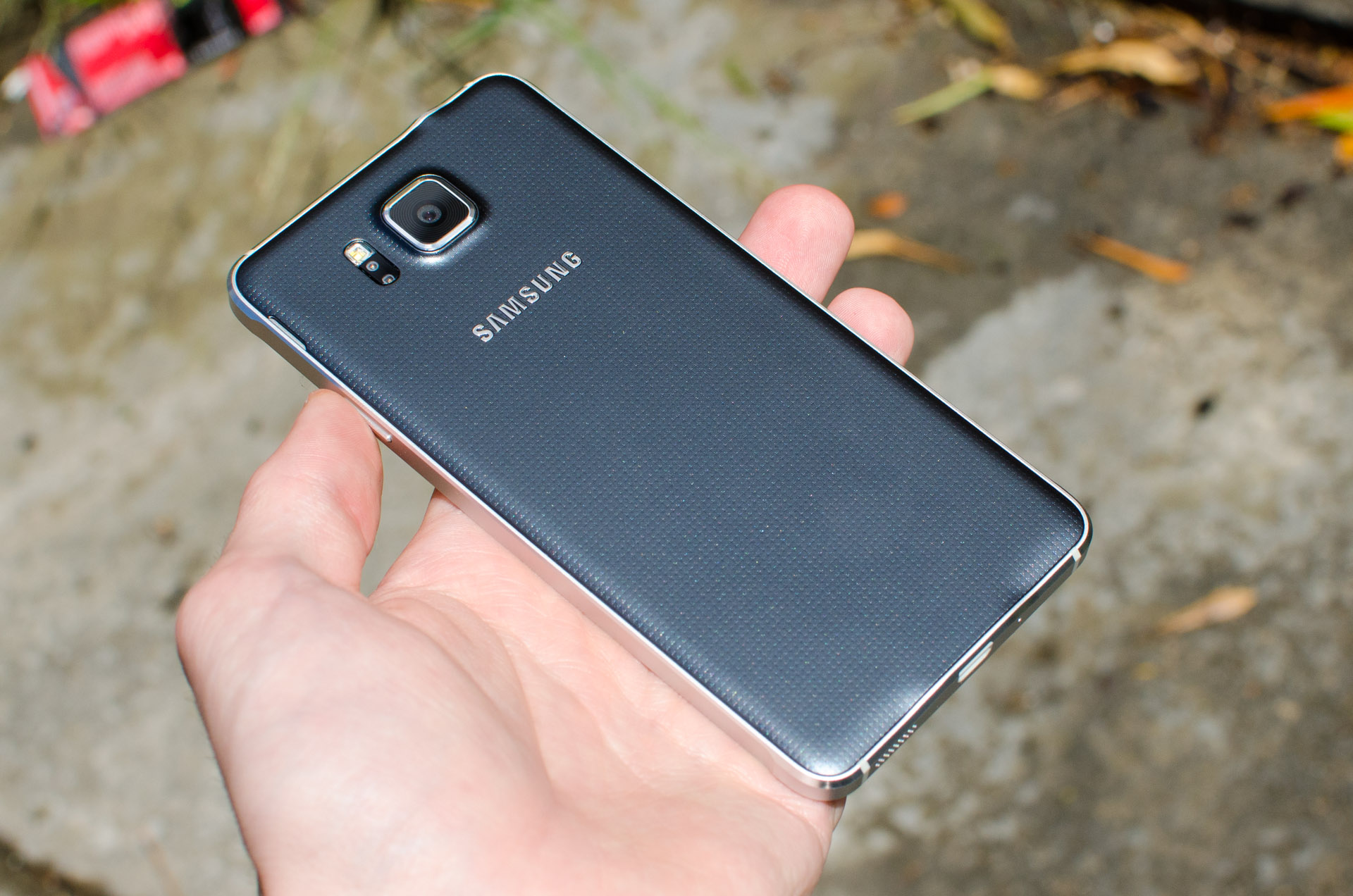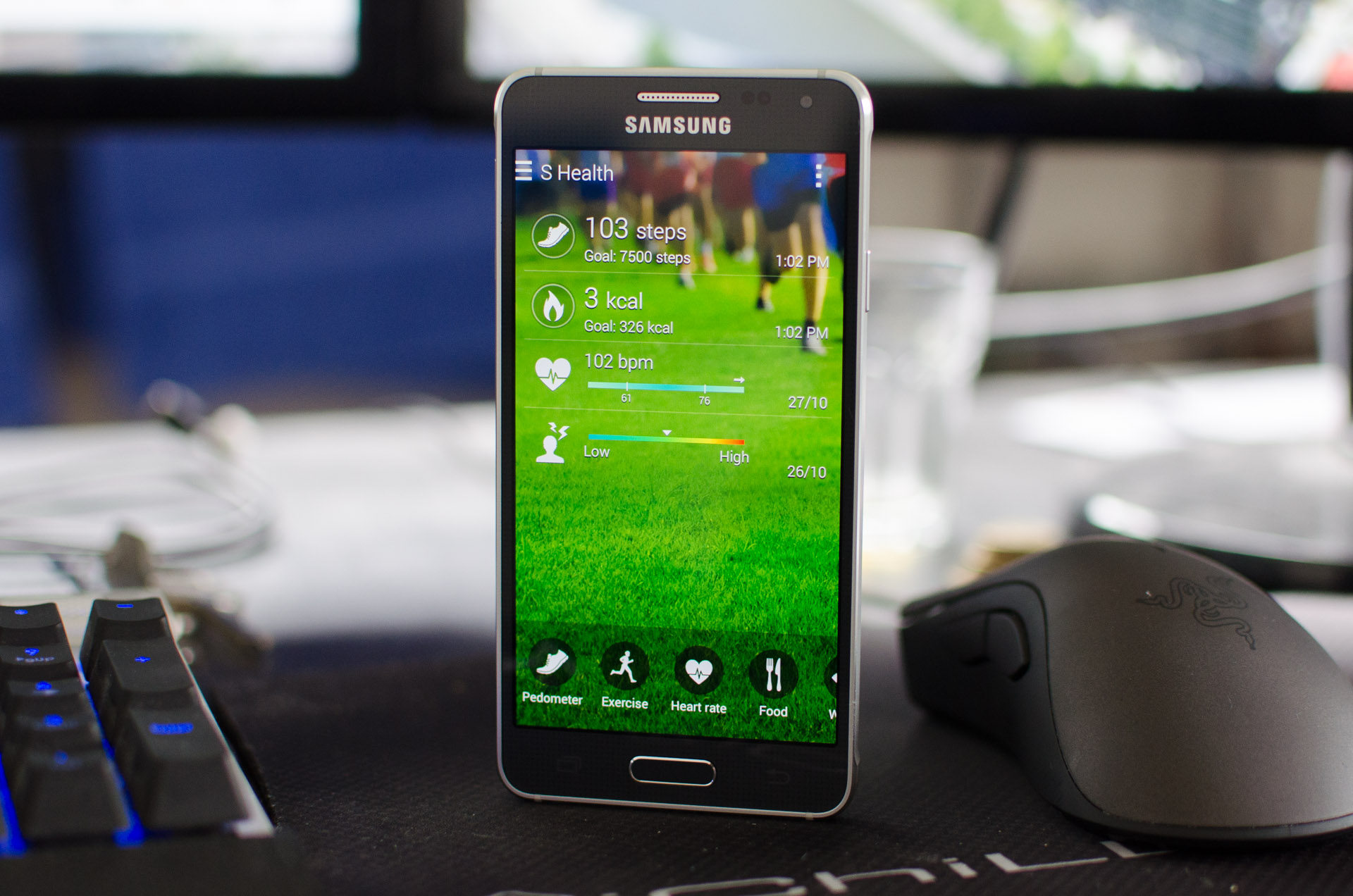Samsung Galaxy Alpha Review
Samsung has been paying more attention to the design of their smartphones lately. Just a few weeks ago I was reviewing the Galaxy Note 4, which packs a fantastic aluminium-magnesium alloy edge that gives the high-finish handset the premium experience information technology deserves. But the Annotation four wasn't the company's kickoff device to use the metallic-clad design; that award goes to the Milky way Blastoff.
The Galaxy Alpha accompanies the Milky way S5 at the top of Samsung's line-up. The four.7-inch device is a smaller alternative to their popular flagship, designed for people who place class at the summit of their priority list. It'south also an experiment with metal, to come across just how well it fits into the rest of a typical Samsung design.

The pick to focus on design has left the Blastoff with slightly downgraded specs compared to the S5. You lot practice get a powerful Snapdragon 801 or Exynos v Octa SoC with 2 GB of RAM, but the 12-megapixel camera, 720p display resolution and i,860 mAh (7.17 Wh) battery are all weaker on newspaper than its bigger brother. Is the hardware trade-off worth it to gain the function-metallic design?
While it's not the first time I've used a metal-clad handset from Samsung, the Blastoff'due south pattern is a massive pace upwardly from similar smartphones Samsung has released over the by 3 years. Premium materials deserve to be integrated into a device that costs more $600, and that's exactly what Samsung has finally realized: cheap plastic just doesn't cutting it anymore.


The aluminium alloy rim replaces the faux-metal (read: painted plastic) strip that has run around the edges of Samsung's flagships for several generations. The difference in texture is immediately noticeable from the moment y'all first touch the Alpha, with the metal giving the handset a stronger, more impressive feel. Not to mention it looks better, as metallic has a genuine shimmer to it that simply can't be replicated with plastic.
Metal isn't the only material the Galaxy Alpha is constructed from. The back console is a removable piece of plastic that has been textured to feel like glossy rubber. The coating is actually quite interesting: it'south more rubberized than the Galaxy S5 or Note 4, which gives it more grip, but at the same time information technology feels greasier than other rubberized plastic devices like the Moto Chiliad. I'm not completely sold on this fabric choice, though it'due south a definite upgrade on the glossy plastic and obviously-fake-leather of old.

The front panel is protected by Gorilla Glass, which is coated in such a style that makes your fingers glide across while operating the touchscreen. There's very little separation between the glass and the AMOLED panel beneath, making the display experience like it's truly at your fingertips. Below the brandish Samsung has included the ineffective fingerprint sensor, alongside capacitive navigation buttons, while the tiptop sees the usual placement of a speaker, camera, sensors and RGB notification LED.
Although Samsung's legal section will endeavour to avoid admitting as much, it's pretty clear that the basic design of the Galaxy Alpha is inspired by the iPhone 5s. I don't think the products look identical, only there are some definite similarities when they are placed adjacent. The Blastoff is being placed equally an Android culling to Apple'due south latest batch of handsets, complete with a like screen size and premium blueprint. The back panels of both devices may be vastly unlike, though Samsung is nevertheless treading a fine line.


Around the edges of the Alpha, Samsung has used extremely solid metal buttons that experience nifty to apply, thanks to near-perfect travel. The volume rocker is on the left, and on the opposite side is the power button in an ergonomic position. The lesser has a micro-USB 2.0 port and the speaker grill, while the elevation has a 3.5mm sound jack. There's no infrared LED on the Alpha, unlike the Galaxy S5 and Note 4.
Although many of the design elements and features are similar to the Milky way S5, the Milky way Alpha is non water resistant. For me this isn't a huge deal, as I never constitute water resistance to be a particularly important feature to accept in a phone. Withal, if y'all're tossing up between the S5 and the Alpha, it'due south worth noting that you won't be able to take underwater selfies or game in the shower.



Aside from the part-metal construction, the aspect of the Alpha's design that impressed me most is how slim and lightweight information technology is. The bulk of the handset's body is 6.7mm thick (up to 8.0mm at the protruding photographic camera), and information technology clocks in 115 grams heavy: 30 grams lighter than the Galaxy S5. Not merely does this make the Alpha marginally slimmer and lighter than the iPhone six, only it keeps the handset extremely portable.
Compared more than closely to Samsung's current standard-sized flagship, the Galaxy S5, the Alpha is around 30% smaller. Information technology may not announced this way when looking at the devices side-past-side, but as soon every bit the Alpha gets in your hands, it's immediately noticeable. Even though the S5 wasn't a cumbersome device to apply by any means, the Alpha is easier to apply, particularly one-handed.



One aspect of the Milky way Alpha that wasn't easier to apply is the middle rate monitor. Located next to the protruding camera array on the dorsum panel, and below the LED flash, the sensor can be hard to activate when yous're not looking at it. This is considering the heart rate monitor is flush with the rest of the back panel, and different with the slightly indented position on the Note 4 and S5, this makes it harder to locate with your finger.
Like well-nigh Samsung devices the thin plastic back cover can be removed to reveal a swappable battery and the nano-SIM slot. While the bombardment does take up a significant portion of the device'due south overall book, the focus on keeping the Alpha slim has resulted in a less-than-impressive total capacity of 7.17 Wh. This is a full 34% smaller than the Galaxy S5, which understandably affects battery life. More on that later in this review.

It is also important to note that there is no microSD card slot below the removable dorsum cover. To be honest, I'g not sure why Samsung decided to remove the microSD slot when the back comprehend is still removable. Surely there'southward enough space underneath the hood to keep a feature that a lot of people want, peculiarly when the internal storage tops out at 32 GB.
Source: https://www.techspot.com/review/910-samsung-galaxy-alpha/
Posted by: kennardengstiong.blogspot.com


0 Response to "Samsung Galaxy Alpha Review"
Post a Comment